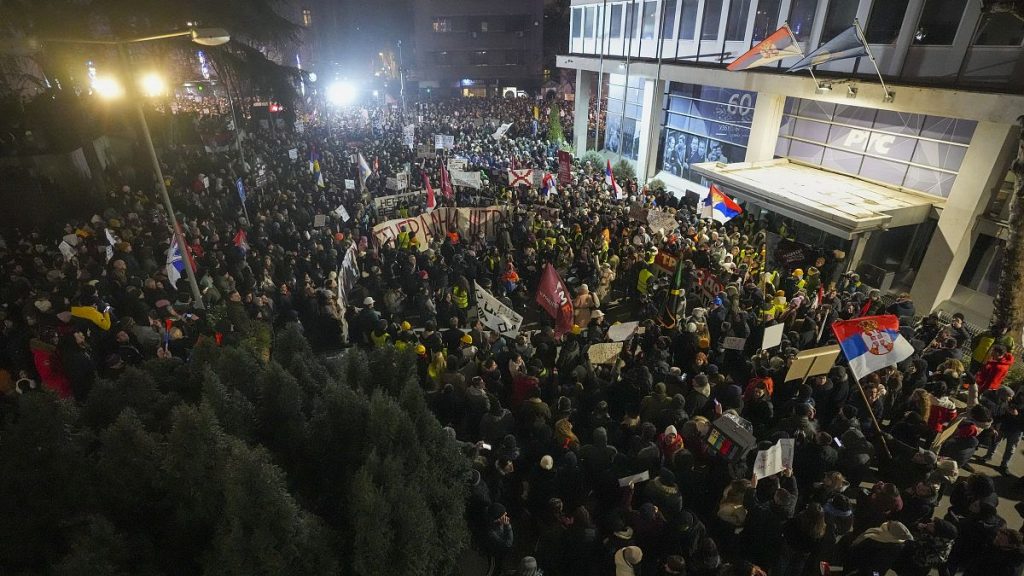The streets of Belgrade reverberated with the voices of tens of thousands of protesters, primarily university students, who gathered outside the headquarters of Serbia’s state television station, RTS, to denounce what they perceived as the broadcaster’s pro-government bias. This demonstration, one of the largest in recent years, unfolded against a backdrop of escalating tensions and widespread discontent across the country. The catalyst for these protests was a tragic incident in November 2023, when a concrete canopy collapsed at the Novi Sad railway station, claiming the lives of 15 individuals. The collapse, attributed by many to government corruption and negligent renovation work linked to deals with Chinese state companies, ignited a firestorm of public anger and amplified existing anxieties about President Aleksandar Vučić’s increasingly authoritarian style of governance.
Fueling the protesters’ ire was RTS’s coverage of the demonstrations, specifically its amplification of President Vučić’s accusations that the protesters were being manipulated by foreign secret services intent on orchestrating a coup. This accusation, viewed by the protesters as an attempt to discredit their legitimate grievances, further solidified their resolve to challenge the government’s narrative and demand accountability. The demonstration outside RTS served as a powerful symbolic act, highlighting the critical role of media in shaping public opinion and the protesters’ determination to resist what they perceived as a manipulation of information. The protesters observed a poignant 15 minutes of silence in memory of the victims of the Novi Sad train station tragedy, a somber reminder of the human cost of the alleged corruption and negligence that sparked the protests. Their calls for a general strike resonated throughout the Balkan nation, reflecting a growing sense of urgency and determination to effect meaningful change.
The protests, initially focused on the Novi Sad tragedy and the subsequent media coverage, quickly evolved into a broader expression of dissatisfaction with President Vučić’s leadership. The protesters’ demands extended beyond accountability for the station collapse to encompass calls for greater democratic freedoms and a more transparent and accountable government. This burgeoning movement reflected a growing unease among segments of Serbian society with what they perceived as Vučić’s increasingly autocratic tendencies and a shrinking space for dissent. The protests, while largely peaceful, were marked by occasional bursts of violence, further escalating tensions between the government and its critics.
A particularly disturbing incident occurred the day before the RTS demonstration, when a driver plowed his car into a group of protesters in Belgrade, seriously injuring a student. This act of violence, captured on video and widely circulated on social media, heightened anxieties and further polarized an already tense situation. Police subsequently apprehended the driver and charged him with attempted murder. This incident, coupled with other reports of violence against protesters, fueled concerns about the safety of demonstrators and raised questions about the government’s response to the protests. The escalating violence underscored the fragility of the situation and the potential for further unrest.
Tensions continued to escalate in the days following the car attack. In Novi Sad, a man brandishing a knife threatened protesters, adding another layer of complexity to an already volatile situation. In a separate incident, riot police forcibly removed a group of opposition politicians who had occupied the Novi Sad City Hall in solidarity with the student protesters. President Vučić condemned the opposition politicians as “hoodlums” and reiterated his vow that they would never seize power through force. He also expressed support for citizens who complained about the disruption caused by the daily protests, particularly the traffic blockades. This stance further alienated the protesters and strengthened their conviction that the government was attempting to suppress their voices.
The opposition, in turn, accused President Vučić of fostering a climate of violence through his rhetoric against the protesters. They argued that his dismissive attitude towards their grievances and his portrayal of them as foreign-backed agitators only served to embolden those who might resort to violence. The clashing narratives and escalating tensions underscored the deep divisions within Serbian society and the urgent need for dialogue and de-escalation. The protests represented a significant challenge to President Vučić’s authority and highlighted the growing demand for greater democratic freedoms and accountability in Serbia. The outcome of this ongoing confrontation remains uncertain, but it is clear that the events of recent months have profoundly impacted the Serbian political landscape and raised crucial questions about the future direction of the country.

